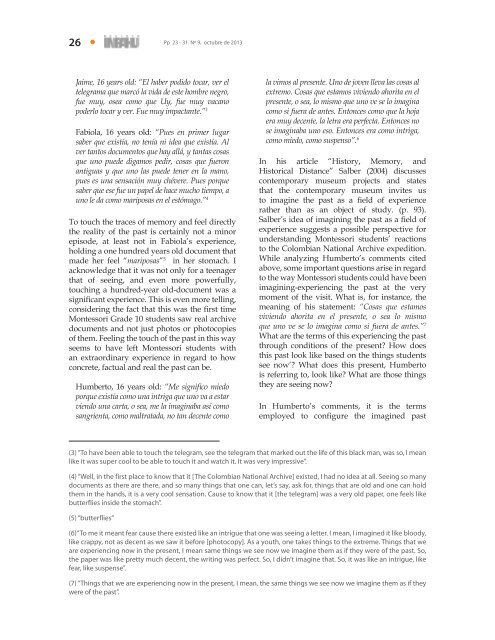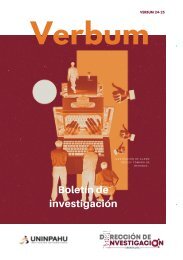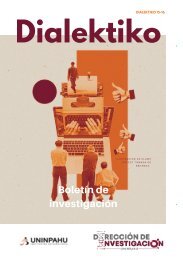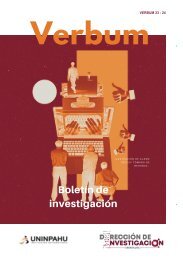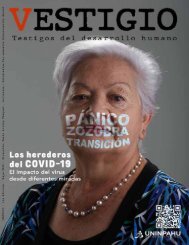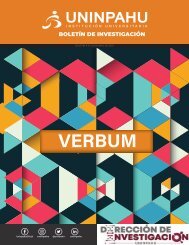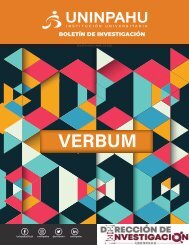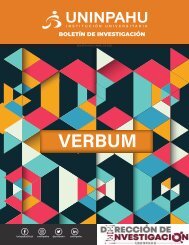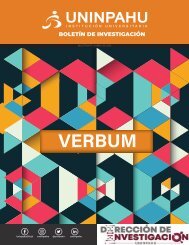Revista UNINPAHU No 9
Revista de investigación UNINPAHU No 9
Revista de investigación UNINPAHU No 9
Create successful ePaper yourself
Turn your PDF publications into a flip-book with our unique Google optimized e-Paper software.
26 Pp 23 - 31. Nº 9, octubre de 2013<br />
Jaime, 16 years old: “El haber podido tocar, ver el<br />
telegrama que marcó la vida de este hombre negro,<br />
fue muy, osea como que Uy, fue muy vacano<br />
poderlo tocar y ver. Fue muy impactante.” 3<br />
Fabiola, 16 years old: “Pues en primer lugar<br />
saber que existía, no tenía ni idea que existía. Al<br />
ver tantos documentos que hay allá, y tantas cosas<br />
que uno puede digamos pedir, cosas que fueron<br />
antiguas y que uno las puede tener en la mano,<br />
pues es una sensación muy chévere. Pues porque<br />
saber que ese fue un papel de hace mucho tiempo, a<br />
uno le da como mariposas en el estómago.” 4<br />
To touch the traces of memory and feel directly<br />
the reality of the past is certainly not a minor<br />
episode, at least not in Fabiola’s experience,<br />
holding a one hundred years old document that<br />
made her feel “mariposas” 5 in her stomach. I<br />
acknowledge that it was not only for a teenager<br />
that of seeing, and even more powerfully,<br />
touching a hundred-year old-document was a<br />
significant experience. This is even more telling,<br />
considering the fact that this was the first time<br />
Montessori Grade 10 students saw real archive<br />
documents and not just photos or photocopies<br />
of them. Feeling the touch of the past in this way<br />
seems to have left Montessori students with<br />
an extraordinary experience in regard to how<br />
concrete, factual and real the past can be.<br />
Humberto, 16 years old: “Me significo miedo<br />
porque existía como una intriga que uno va a estar<br />
viendo una carta, o sea, me la imaginaba así como<br />
sangrienta, como maltratada, no tan decente como<br />
la vimos al presente. Uno de joven lleva las cosas al<br />
extremo. Cosas que estamos viviendo ahorita en el<br />
presente, o sea, lo mismo que uno ve se lo imagina<br />
como si fuera de antes. Entonces como que la hoja<br />
era muy decente, la letra era perfecta. Entonces no<br />
se imaginaba uno eso. Entonces era como intriga,<br />
como miedo, como suspenso”. 6<br />
In his article “History, Memory, and<br />
Historical Distance” Salber (2004) discusses<br />
contemporary museum projects and states<br />
that the contemporary museum invites us<br />
to imagine the past as a field of experience<br />
rather than as an object of study. (p. 93).<br />
Salber’s idea of imagining the past as a field of<br />
experience suggests a possible perspective for<br />
understanding Montessori students’ reactions<br />
to the Colombian National Archive expedition.<br />
While analyzing Humberto’s comments cited<br />
above, some important questions arise in regard<br />
to the way Montessori students could have been<br />
imagining-experiencing the past at the very<br />
moment of the visit. What is, for instance, the<br />
meaning of his statement: “Cosas que estamos<br />
viviendo ahorita en el presente, o sea lo mismo<br />
que uno ve se lo imagina como si fuera de antes.” 7<br />
What are the terms of this experiencing the past<br />
through conditions of the present? How does<br />
this past look like based on the things students<br />
see now’? What does this present, Humberto<br />
is referring to, look like? What are those things<br />
they are seeing now?<br />
In Humberto’s comments, it is the terms<br />
employed to configure the imagined past<br />
(3) “To have been able to touch the telegram, see the telegram that marked out the life of this black man, was so, I mean<br />
like it was super cool to be able to touch it and watch it. It was very impressive”.<br />
(4) “Well, in the first place to know that it [The Colombian National Archive] existed, I had no idea at all. Seeing so many<br />
documents as there are there, and so many things that one can, let’s say, ask for, things that are old and one can hold<br />
them in the hands, it is a very cool sensation. Cause to know that it [the telegram] was a very old paper, one feels like<br />
butterflies inside the stomach”.<br />
(5) “butterflies”<br />
(6)“To me it meant fear cause there existed like an intrigue that one was seeing a letter. I mean, I imagined it like bloody,<br />
like crappy, not as decent as we saw it before [photocopy]. As a youth, one takes things to the extreme. Things that we<br />
are experiencing now in the present, I mean same things we see now we imagine them as if they were of the past. So,<br />
the paper was like pretty much decent, the writing was perfect. So, I didn’t imagine that. So, it was like an intrigue, like<br />
fear, like suspense”.<br />
(7) “Things that we are experiencing now in the present, I mean, the same things we see now we imagine them as if they<br />
were of the past”.


